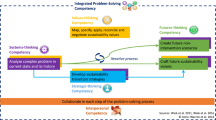Abstract
As higher education addresses the challenges of climate neutrality and sustainability, responsibilities mount on leaders of interdisciplinary environmental and sustainability academic programs (IEPs). Sustainability operations and academic programs help create cultures of sustainability, engaging students, faculty, and staff. As this culture develops, it must mesh with the planning, budgeting, and decision-making processes of senior administrators. This integration process requires an interdisciplinary approach to understand the differing missions and objectives, vocabularies and key concepts, administrative structures, and cultures not just across all academic units but also across all non-academic units. Organization of sustainability activities takes a wide range of forms, from a centralized model where academics and operations are combined within a single unit to a distributed model where sustainability curricula, co-curricula, planning, and operations take place in a variety of units, linked through campus committees and sustainability plans. This paper examines the challenges and tested solutions to address sustainability leadership at an institutional level, across the range of organization models, from centralized to distributed. One common element of these solutions is top-down commitment, combined with bottom-up participation in the development and implementation of new efforts in sustainability education and operations.
Similar content being viewed by others
References
Barlett PF, Chase GW (eds) (2013) Sustainability in higher education: stories and strategies for transformation. The MIT Press, Cambridge
Brinkhurst M, Rose P, Maurice G, Ackerman JD (2011) Achieving campus sustainability: top-down, bottom-up, or neither? Int J Sustain High Educ 12(4):338–354
Hanover Research Institute (2011) Embedding sustainability into university curricula. Academy Administration Practices Report. Washington DC. 32pp. http://www.niu.edu/ese/images/attachments/Embedding%20Sustainability%20into%20University%20Curricula.pdf). Accessed March 12, 2015
Parnell RA Jr, Berutich L, Henn A, Koressel N (2014) Campus as a learning laboratory: linking facilities, operations, and community engagement to undergraduate research and internship opportunities. Counc Undergrad Res Q 35(1):11–19
Presidentsclimatecommittment.org (2015) http://www.presidentsclimatecommitment.org/. Accessed March 15, 2015
Second Nature (2011) Institutionalizing sustainability. Viewpoints on sustainability from Second Nature. http://presidentsclimatecommitment.org/resources/publications/viewpoints/institutionalizing-sustainability. Accessed March 12, 2015
Shriberg M, MacDonald L (2013) Sustainability leadership programs; emerging goals, methods and best practices. J Sustain Educ V06:1–16
Vincent S, Bunn S, Stevens S (2013) Sustainability education: results from the 2012 census of US four year colleges and universities. National Council for Science and the Environment, Washington, DC, 30pp
Vincent S, Dutton K, Santos R, Sloan L, Parnell R (2014) Interdisciplinary environmental and sustainability education and research: leadership and administrative structures. Center for Environmental Education Research, National Council for Science and the Environment, Washington, DC
Acknowledgments
The author appreciates the opportunity to spend his sabbatical leave from Northern Arizona University visiting sustainability programs across the country. Numerous discussions with colleagues including Laura Huenneke, John Morris, Erik Nielsen, Ellen Vaughan, and Shirley Vincent contributed greatly to the development of the manuscript. The comments of two anonymous reviewers significantly strengthened the final manuscript.
Author information
Authors and Affiliations
Corresponding author
Rights and permissions
About this article
Cite this article
Parnell, R. Grassroots participation integrated with strong administration commitment is essential to address challenges of sustainability leadership: tools for successfully meeting in the middle. J Environ Stud Sci 6, 399–404 (2016). https://doi.org/10.1007/s13412-015-0319-8
Published:
Issue Date:
DOI: https://doi.org/10.1007/s13412-015-0319-8




